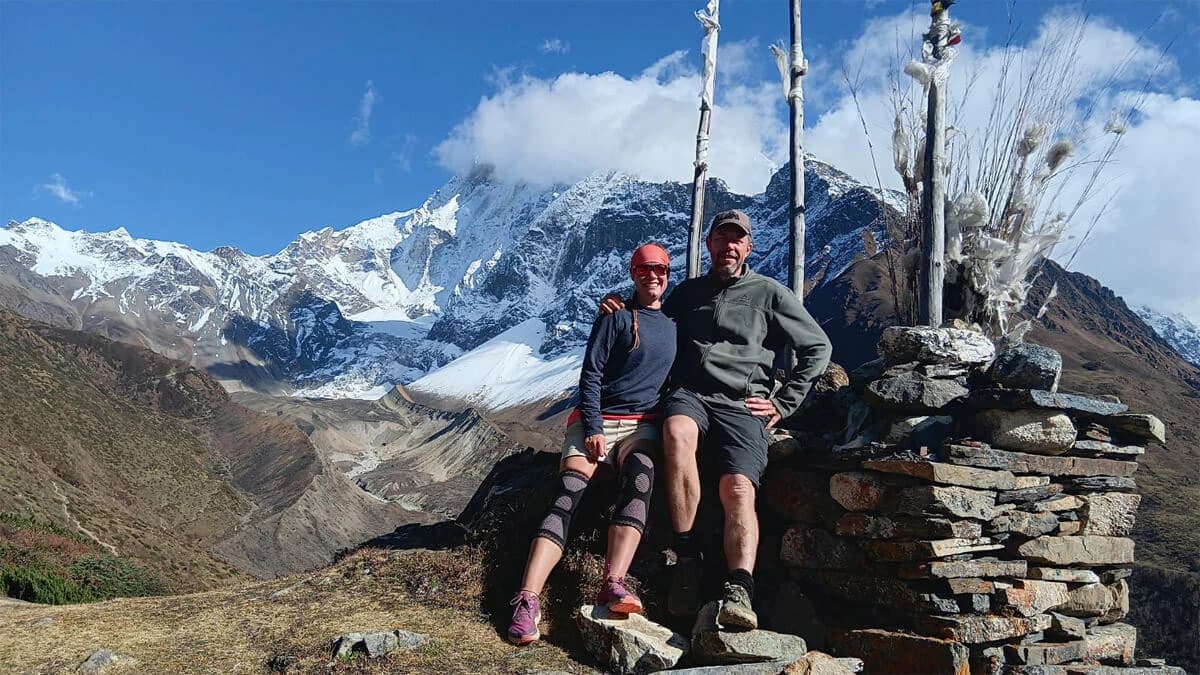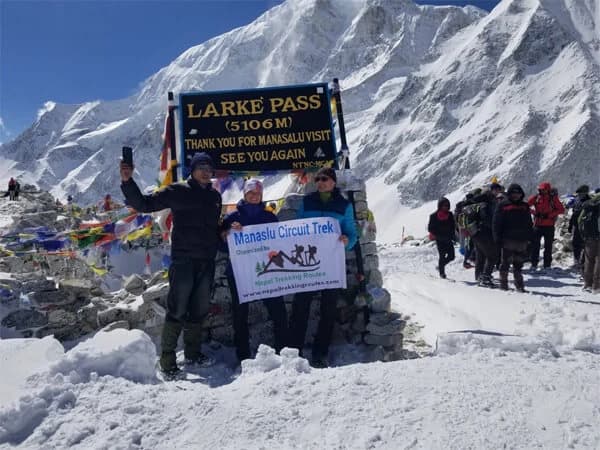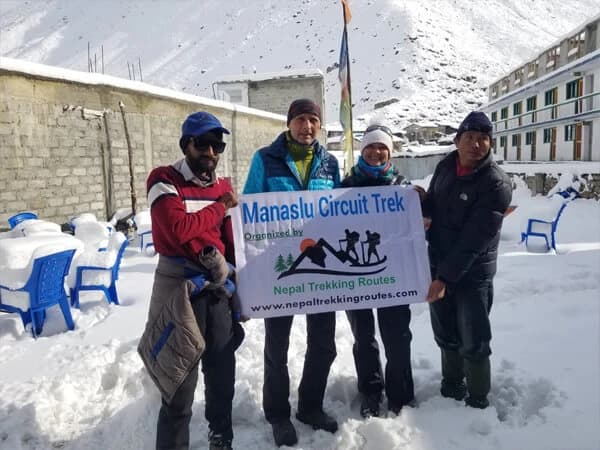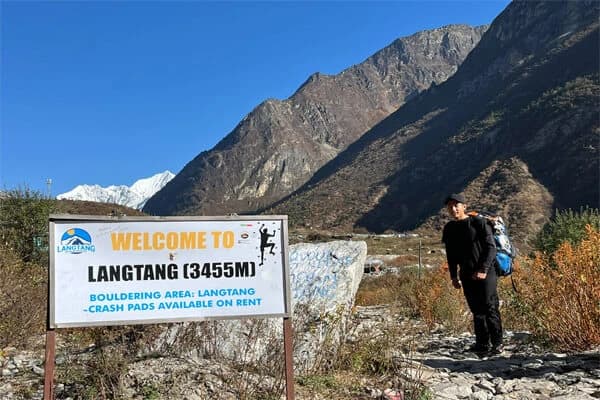Away from crowded trails, the Manaslu Circuit Trekking Adventure provides an unique and isolated Himalayan experience. Trekkers take in expansive vistas of Mt. Manaslu, Ganesh Himal, and Himalchuli as they traverse untamed terrain, steep gorges, and high mountain passes, such as the well-known Larkya La Pass. Interactions with Gurung, Tibetan, and Nubri people along the way offer a glimpse into their long-standing customs, monasteries, and warm hospitality. The trek is demanding yet rewarding, requiring acclimatization, fitness, and environmental awareness.
Walk the Wild Heart of Nepal – Manaslu Circuit Trek Adventure
For good reason, many people refer to the Manaslu Circuit Trekking Adventure as a trip into the wild heart of Nepal. Manaslu offers solitude, unspoiled scenery, and unexplored mountain culture in contrast to the crowded trekking routes of Everest or Annapurna. This trek rings 8,163-meter-tall Mt. Manaslu, the eighth-highest mountain in the world. The Sanskrit word Manasa, which means "soul" or "spirit," is the source of the name "Manaslu," and the walk is genuinely a soulful experience. You will see the change from the initial steps. Commercial towns and busy tea cafes are absent.
Rather, you traverse isolated communities, terraced fields, thick forests, and beautiful river basins sculpted by the Budhi Gandaki River. You ascend higher each day on the route, passing by historic monasteries, prayer flags, and snow-capped summits. It is a cultural experience as well as an adventure.
This walk is unique because it is genuine. Along the route, you will see people who continue to live traditional lives influenced by Tibetan Buddhism. Not only will you be trekking in the mountains, but you will also be seeing a way of life that has not changed in decades. Manaslu is a genuine hidden gem in Nepal because of this.
Where is Manaslu? – Geography and Location
Manaslu Trek Nepal in the Heart of the Himalayas
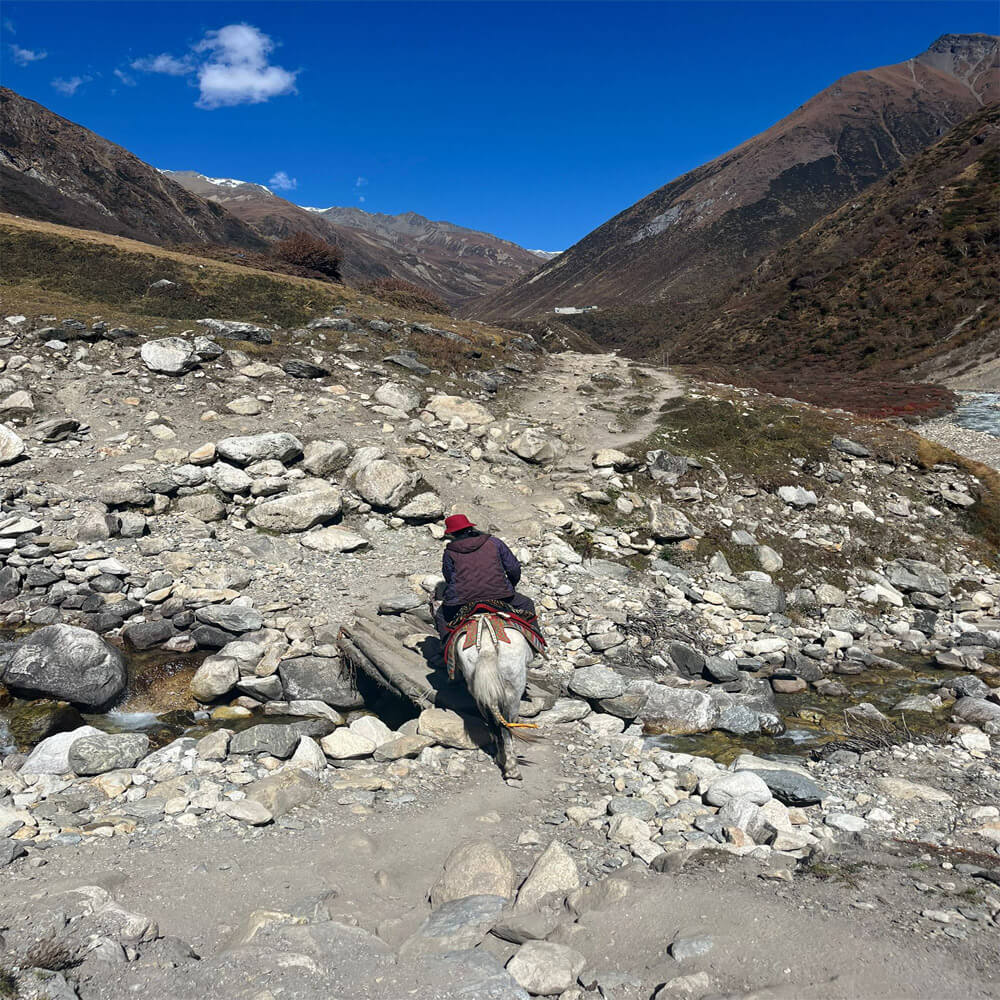
Nestled between the Annapurna Region trek to the west and the Langtang region trek to the east, Manaslu is located in the west-central region of Nepal. Over 1,663 square kilometers of protected territory make up the Manaslu Conservation Area (MCA), which includes the area. The magnificent Mount Manaslu (8,163 meters), the eighth-highest mountain in the world, is at its center. Known as the "Mountain of the Spirit," Manaslu derives its name from the Sanskrit word Manasa, which means "soul" or "spirit." With its steep slopes, ice summits, and deep river gorges sculpted by the Budhi Gandaki River, Manaslu is still peaceful, unspoiled, and naturally stunning in contrast to the crowded Everest or Annapurna regions.
Villages, Landscapes, and Cultural Borders
With rice fields, waterfalls, and subtropical forests all around, the trek starts in lower, milder locations like Sotikhola or Machha Khola. The landscape changes to yak pastures, pine forests, and snow-covered valleys as you climb. Villages like as Namrung, Lho, Sama Gaun, and Samdo are examples of traditional Himalayan living and Tibetan culture. People have been trading salt, wool, and plants across steep mountain passes for ages, and these communities are near the Tibetan border. Mani walls border stone walkways, prayer flags fly along routes, and chortens silently perch above hillsides, serving as a reminder to trekkers that this area is not only geographically isolated but also spiritually rich. Manaslu is one of Nepal's most genuine and soulful trekking destinations because of its unique combination of breathtaking scenery and a strong Buddhist culture.
Why Choose Manaslu Circuit Trek?
Off-the-beaten-path trek in Nepal
The Manaslu Circuit is serene and unspoiled beauty is one of the main factors influencing trekkers' decisions. Manaslu provides seclusion in contrast to the crowded routes of Everest or Annapurna. The trails meander past untamed rivers, serene villages, rugged cliffs, and dense forests. For hours, you can stroll while listening to the sound of birds, waterfalls, and prayer flags flapping in the breeze. You are alone with the untainted heart of the mountains on this walk, which feels like traveling back in time because there are no tourists or commercial distractions. Every day is an adventure because of the ever-changing landscape, which ranges from terraced farms and lush hills to snow-capped peaks and glaciers.
Culture That Feels Real and Unfiltered
The rich cultural experience is another factor in the decision to go on this expedition. Ethnic Gurung and Tibetan-influenced Nubri and Tsum Valley communities reside in the Manaslu region. Villages such as Sama Gaun, Deng, Namrung, and Jagat continue to practice ancient customs. Monks singing in silent gompas, yak caravans, hanging butter lamps in monasteries, stone mani walls, and colorful prayer wheels are all visible. The people there are friendly, give butter tea, dress traditionally, and speak Tibetan dialects. Far from the contemporary world, life feels straightforward and raw here.
You stay in family-run teahouses, eat handmade dal bhat, and hear stories by the fire in place of crowded hotels. To choose Manaslu is to choose genuineness. It is perfect for those seeking a strenuous trek, a vibrant culture, and untamed, unbridled nature. Every step you take here narrates a tale of human tenacity, faith, and mountains.
Manaslu Circuit Trekking Adventure Highlights
The Manaslu Circuit Trekking trip provides the ideal balance of unspoiled nature, stunning culture, and intense Himalayan difficulty. Trekkers traverse traditional villages like Samagaon and Lho, where Tibetan-influenced culture is still prevalent, as well as verdant forests and steep valleys. Crossing the spectacular Larkya La Pass (5,160m), which provides stunning views of the Annapurna, Himlung, and Mount Manaslu ranges, is the highlight. Trekkers see glaciers, yak pastures, historic monasteries, and the serene allure of the Manaslu Conservation Area when traveling through these places. The trek is one of Nepal's most fulfilling and remarkable adventure experiences because of the fewer tourists, unspoiled scenery, and genuine mountain life.
Crossing the Legendary Larkya La Pass (5,160m)
The exciting crossing of Larkya La Pass, one of Nepal's longest and most stunning high passes, is the main attraction of the Manaslu Circuit Trek. With towering peaks all around, the ascent starts before daylight and winds through ice pathways and sparkling snow. It is difficult because of the chilly winds and thin air, but once you get to the top, it all seems worthwhile. You may enjoy stunning views of Himlung Himal, Cheo Himal, Kang Guru, and Mt. Manaslu from the pass. You feel like you are on top of the world as vibrant prayer flags flutter in the breeze. It is a long but breathtakingly beautiful descent to Bimthang.
Close-Up Views of Mt. Manaslu and Other Himalayan Giants
The eighth-highest mountain in the world, Mt. Manaslu (8,163m), dominates the skyline during the trek. The vistas are even more magnificent as you ascend, particularly close to settlements like Lho, Shyala, and Sama Gaun. For even closer views, trekkers frequently make a detour to Pungyen Gompa or Manaslu Base Camp. The journey offers breathtaking views of Ganesh Himal, Himalchuli, Ngadi Chuli, and Shringi Himal in addition to Manaslu. Starry nights, bright sunrises, and snow-capped peaks make every step unforgettable.
Remote Villages and Tibetan Culture
The Manaslu Circuit provides a unique opportunity to stroll among communities where time appears to have stopped. Ancient monasteries, smiling residents, whirling prayer wheels, and traditional stone homes all demonstrate the strong Tibetan influence. Buddhist culture is prevalent in villages such as Sama Gaun, Samdo, and Lho. Mani walls, chortens, prayer flags, and yak caravans are among the sights that evoke a feeling of tranquility and spirituality. The cultural experience feels genuine and unspoiled since the residents still speak Tibetan dialects, dress traditionally, and adhere to long-standing traditions.
Dramatic Landscapes and Wild Trails
The Manaslu Circuit is constantly shifting scenery is among its most distinctive features. In the lower parts of the journey, there are waterfalls, rice terraces, and verdant woodlands. The landscape gradually changes to steep gorges, thundering rivers, and sheer cliffs. The climate changes as you get higher into the alpine zone, which is chilly, arid, and covered in snow and glaciers. Alongside the trail, the strong Budhi Gandaki River runs, and trekkers traverse exhilarating suspension bridges that span deep canyons. The excursion feels genuinely wild because of the raw splendor of nature.
Ancient Monasteries and Spiritual Sites
One of the main attractions of this walk is its spirituality. You will pass centuries-old monasteries like Ribung Monastery and Pungyen Gompa along the way. These hallowed locations rest serenely against the backdrop of enormous mountains. Butter lamps, spinning prayer wheels, colorful murals, and the gentle chanting of monks all contribute to the calm ambiance. Many trekkers spend time sitting quietly or meditating. These experiences serve as a reminder that the Manaslu trek is a spiritual as well as a physical trip.
Manaslu Circuit Trek Itinerary
One of the best restricted area treks in Nepal, the Manaslu Circuit Trek 14 Days Itinerary offers trekkers a secluded Himalayan experience replete with high passes, scenic scenery, and cultural diversity. It usually takes 12 to 21 days to complete this trek, depending on your pace and itinerary.
Trekkers must get restricted area permits at Soti Khola or Arughat, where the expedition often begins. Trekking through subtropical woods, terraced farms, and local communities for the first few days offers a mild introduction to adventure trekking in Nepal. Important early destinations include Dharapani, Jagat, and Machha Khola, where teahouses provide simple lodging and regional cuisine.
Trekkers encounter more breathtaking Himalayan landscape as they ascend the mountain, passing through Tal, Namrung, and Samagaon. Along the route, villages give opportunities to observe genuine highland customs, monasteries, and Tibetan-influenced culture. Walking five to eight hours a day helps the body gradually adjust to high-altitude environments.
Larkya La Pass (5,160m), the highest point in the Manaslu Circuit, is a crucial highlight of the journey. This pass, which offers expansive views of Manaslu, Himalchuli, and Ngadi Chuli, is both physically taxing and rewarding to cross. Managing altitude sickness requires proper pacing, hydration, and acclimatization.
Trekkers enjoy easier terrain and abundant flora as they traverse Samdo, Bimtang, and Dharapani after descending Larkya La. Depending on your route, the walk ends at either Besisahar or Arughat.
Carrying necessary equipment, employing a guide or porter, and lodging in clean teahouses all contribute to safety and comfort during the journey. With its combination of difficult terrain, stunning Himalayan scenery, and cultural immersion, the Manaslu Circuit is a shining example of adventure trekking in Nepal. For those looking for a genuine Himalayan adventure, its ranking as one of best restricted area treks in Nepal ensures a sense of isolation, exploration, and achievement.
Trekkers looking for a well-organized, safe trekking experience who wish to discover secluded paths, immerse themselves in the local way of life, and take in the splendor of the Nepalese Himalayas would love this itinerary.
Manaslu Circuit Trek Difficulty
Remote Trails and Rugged Terrain
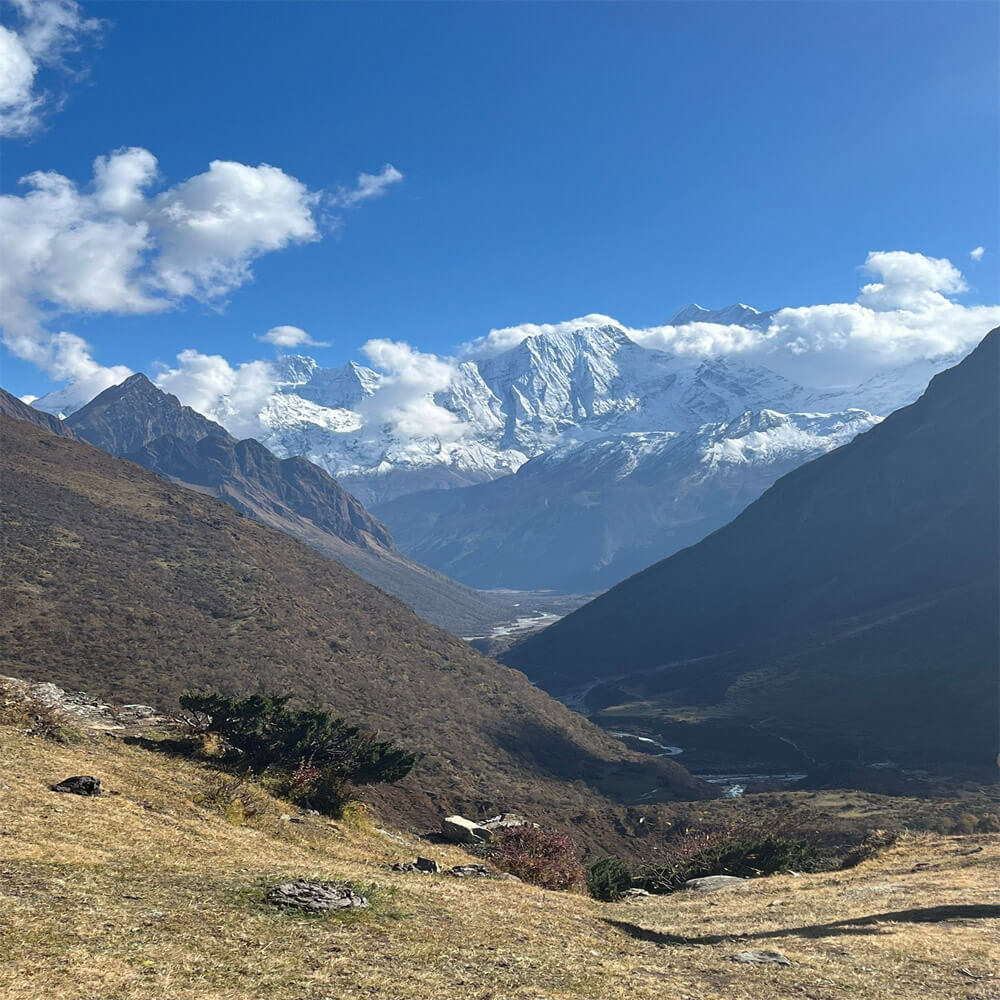
The Manaslu Circuit is both stunning and difficult because it is located in one of untouched trekking regions of Nepal. Compared to Everest or Annapurna, the trails are less marketed, which means there are less amenities and tougher terrain. Trekkers frequently traverse steep ascents, landslide-prone regions, suspension bridges, and rough routes. This makes the Nepal trekking adventure much more challenging.
High Altitude Challenges
The altitude is one of the most difficult aspects of this climb. At Larkya La Pass, the route ascends to 5,160 meters. Because oxygen levels are lower at these elevations, altitude sickness is more likely to occur. Trekkers who climb too quickly may suffer from headaches, nausea, or exhaustion. To successfully finish the trip, appropriate acclimatization days in locations like Samagaon or Samdo are necessary.
Weather and Temperature Extremes
This region of Nepal experiences erratic weather. While afternoons can bring rain, snow, or strong winds, mornings can be sunny and clear. Particularly at higher altitudes, winter temperatures can fall below freezing. This Nepal trekking adventure becomes much more challenging due to the weather.
Physical Fitness and Preparation Needed
As you walk six to eight hours every day for over two weeks, the trek requires a high level of stamina. Strong legs, a sound heart, and mental resolve are necessary for long descents, continuous uphill climbs, and thin air. It is extremely encouraged to train with aerobic, hiking, and strength activities.
Why It’s Worth the Challenge
Despite the difficulty, the Manaslu Circuit rewards trekkers with dramatic landscapes, glacier views, and unique Tibetan-influenced culture. Being one of the untouched trekking regions of Nepal, it offers peace, authenticity, and raw Himalayan beauty—perfect for those seeking a true Nepal trekking adventure off the beaten path.
Cultural and Spiritual Experience
Tibetan-Influenced Heritage and Village Life
Entering the Manaslu Circuit feels similar to entering a living Tibetan cultural museum. Tibetan-born residents of several villages, including Sama Gaun, Lho, and Samdo, have been maintaining their customs for many years. Yaks grazing outside of residences, wooden balconies, prayer wheels spinning in the wind, and stone-built dwellings are all visible. The locals continue to practice old traditions and speak their unique dialects.
Every village features chortens (Buddhist temples) at the entryway, mani walls adorned with prayer carvings, and vibrant prayer flags flying across rooftops. Monks in red robes stroll silently down the paths as you pass through these settlements, and youngsters greet you with "Tashi Delek." Simple, serene, and closely entwined with nature is life.
Monasteries, Prayer Rituals, and Spiritual Moments
The trek has a spiritual rhythm thanks to the monasteries along the route. Located on hilltops overlooking snow-covered mountains, sites like Lho Village's Ribung Monastery and Pungyen Gompa are centuries old. There are Buddha statues, cloth-wrapped prayer books, thangka paintings, and butter lamps within.
Here, trekkers frequently stop to hear the monks' gentle chanting and the sound of horn blowing during morning prayers. The setting promotes silent contemplation, and the air is heavy with the scent of incense. Regardless of your religious beliefs, the serene setting, mountains, and age-old customs inspire and soothe you. The Manaslu region is a spiritual trip as much as a place to trek.
Daily Life on the Trail
A Typical Day of Trekking around Mount Manaslu
A typical day of trekking begins early. Trekkers awaken to the sound of roosters or bells at around six in the morning. The journey for the day starts with a warm breakfast of tea, porridge, or Tibetan bread. For five to seven hours, you walk via large suspension bridges, pine trees, and waterfalls. As you ascend, the trail gradually transitions from verdant slopes to stony pathways and frozen scenery.
Usually, a little teahouse along the route serves lunch. Trekkers take breaks, rehydrate, and eat foods like momo (dumplings), dal bhat, or noodles. When you arrive at the next settlement in the afternoon, you check into a teahouse and warm yourself with a cup of hot soup or tea. Trekkers congregate around the dining room stove in the evening to exchange tales and make plans for the following day.
Tea house trekking in Manaslu region
Local families operate teahouses, which are modest but comfortable lodges. The friendliness of the hosts makes every stay unforgettable, even though the rooms are simple and frequently include shared toilets, hardwood mattresses, and heavy blankets. Everyone sits near to the yak dung stoves used for heating at higher elevations in order to remain warm.
The food is prepared and fresh. The most popular meal, daal bhat (rice, lentil soup, and veggies), is nutritious and served at most lodges without limits. Additionally, you can savor yak cheese in Sama Gaun, apple pie in Lho, and butter tea in Samdo.
Challenges and Adventure Factors
High Altitude and Acclimatization
The high altitude is one of the main obstacles on the Manaslu Circuit Trek. As you go from low slopes to isolated Himalayan communities like Samagaun and Samdo, the trail progressively gains altitude. Above 3,000 meters, altitude sickness might begin. Trekkers must take it leisurely, stay hydrated, and factor in acclimatization days to prevent this. Before ascending higher, spending a night or two at Samagaun aids in the body's adaptation to the thin air.
Larke La Pass trek
At 5,160 meters, the Larkya La Pass is the trek's highest point. Throughout the entire trip, this is the most difficult day. Around three or four in the morning, you begin your early, gloomy walk. The air is exceedingly thin, and the ascent is long, windy, and chilly. However, breathtaking views of Himlung Himal, Cheo Himal, and the enormous glacier below await you once you reach the summit. In the event of snow or ice, the descent may be slick.
Unpredictable Weather Conditions
In the Manaslu region, the weather can change rapidly. While the afternoons bring clouds, rain, or snow, the mornings may be sunny and blue. On the pass, snow may obstruct the trail in the winter or early spring. For this reason, it is crucial to trek during the appropriate season and to pack warm clothes, waterproof layers, and sturdy trekking boots.
Remote Himalayan trekking routes
There are fewer teahouses and other basic amenities along the Manaslu trail than on well-known treks like Everest or Annapurna. Some places only serve basic meals, have little electricity, and no Wi-Fi. Heating and hot showers are not always available. The trekkers have to become used to living simply, sleeping in small rooms, using communal restrooms, and consuming regional cuisine such as noodle soup, Tibetan bread, or dal bhat. But it is also this simplicity that gives the journey a genuine, raw feel.
Manaslu Circuit Trek Map
You will see a circular track on a Manaslu Circuit Trek mapthat begins at Soti Khola or Machha Khola, travels down the Budi Gandaki River, and then circles Mount Manaslu (8,163m). The protected Manaslu Conservation Area, which includes the entire trail, is renowned for its historic monasteries, traditional Gurung and Tibetan-influenced settlements, and abundant biodiversity.
Before crossing the high Larkya La Pass (5,160m), the Manaslu Circuit Trek route travels through a number of important locations, including Jagat, Deng, Namrung, Lho, Samagaon, Samdo, and lastly Dharamsala. Following the pass, the path falls in the direction of Dharapani and Bhimthang before joining the Annapurna region.
The map also shows side routes that lead to Pungen Gompa and Manaslu Base Camp, as well as glaciers encircling the base of Mount Manaslu. There are visible signs indicating restricted entry to the Manaslu Conservation Area, where hikers require special permits and a certified guide.
Trekkers can learn about elevation gains, settlement sites, acclimatization points, and alternate pathways by examining the map. It is a useful tool for preparation, safety assurance, and soaking up the remote beauty of Manaslu Circuit Trek route.
Best Time to Trek Manaslu Circuit
Manaslu Circuit Trekking in Autumn Season (September to November) – The Perfect Season
As far as trekking the Manaslu Circuit is concerned, autumn is the ideal season. The skies are clear, the weather is steady, and the views of the mountains are at their best. At lower elevations, it is neither too hot nor too chilly. The air seems clear and clean, and rhododendron woodlands turn red and golden. Additionally, local holidays like Dashain and Tihar occur around this season, giving trekkers a chance to observe Nepalese customs and hamlet celebrations.
Manaslu Circuit Trekking in Spring Season (March to May) – A Season of Blossoms
The second-best time of year for this walk is in the spring. In higher elevations, the snow starts to melt as the temperature rises. As rhododendron and wildflowers blossom throughout the hills, the forests become more colorful and lively. Even if clouds could show up in the afternoons, it is still possible to see Manaslu, Ganesh Himal, and other peaks. Nature lovers and photographers will also adore this time of year.
Manaslu Circuit Trekking in Winter Season (December to February) – Beautiful but Harsh
Clear mountain views, quiet routes, and fewer trekkers are all available in the winter. It does, however, bring with it bitter cold, a lot of snow, and a significant likelihood of Larkya La Pass being blocked. Particularly in upper villages like Dharamsala and Samdo, nights can fall below -15°C. In winter, only well-equipped and experienced trekkers should try this route.
Manaslu Circuit Trekking in Monsoon Season (June to August) – Not Recommended
In lower regions, the monsoon season brings leeches, muddy pathways, landslides, and a lot of rain. Most of the time, clouds obscure views of the mountains. Trekking becomes dangerous and uncomfortable even though the woodlands appear lush and verdant. But because the upper Manaslu region is under a rain shadow and receives less rainfall, adventurers can still travel there.
Manaslu Circuit Trek Permits and Regulations
Manaslu Circuit Trek Permit
The Manaslu Circuit is not as open to trekking as the Annapurna or Langtang because it is a restricted trekking area in Nepal. The Nepali government needs a number of permits to safeguard its ecology, culture, and border security. The Department of Immigration's Manaslu Restricted Area Permit (RAP) is the most crucial. Solo trekking is absolutely prohibited, and this permission may only be obtained through authorized trekking services. Because the track leaves through the Annapurna region after Larkya La Pass, you also need the Manaslu Conservation Area Permit (MCAP) and the Annapurna Conservation Area Permit (ACAP). These permits aid in community development, conservation initiatives, and trail maintenance.
Rules You Must Follow on the Trail
There are obligations associated with trekking in the Manaslu Conservation Area. According to government regulations, each trekker must accompany at least two individuals and a certified guide. Photographing sacred objects without permission, damaging wildlife, or camping inside monasteries are all discouraged. Due to restrictions on firewood harvesting to preserve forests, the majority of teahouses heat their buildings with gas or yak dung. Trekkers should observe local traditions, such as walking around mani walls and stupas in a clockwise direction and taking off shoes before entering houses or monasteries. Respecting these basic environmental and cultural norms contributes to maintaining the integrity of this holy Himalayan area.
Manaslu Circuit Trek Distance and Duration
Total Trekking Days and Walking Hours
Depending on weather, acclimatization days, and trekking pace, the Manaslu Circuit Trek typically takes 14 to 18 days. The majority of itineraries finish at Dharapani or Besisahar after starting in Soti Khola or Machha Khola. Before climbing Larkya La Pass (5,160 meters), trekkers typically walk for five to seven hours each day, passing through villages like Jagat, Deng, Namrung, Lho, Samagaun, and Samdo. One day at Samagaun, frequently accompanied by a trek to Manaslu Base Camp or Pungyen Gompa, and another day at Samdo, with a quick stroll towards the Tibet border, are highly recommended for acclimatization. By allowing your body to acclimate to the altitude, these rest days lower your chance of developing acute mountain sickness (AMS).
Manaslu Circuit Trek distance Covered
Depending on where you start and finish, the Manaslu Circuit can be anywhere from 177 to 200 kilometers long. The first few days follow the deep Budi Gandaki River Gorge, with its narrow trails that gradually ascend through rice fields, suspension bridges, and waterfalls. The scenery shifts as you ascend, offering vistas of snow-capped peaks, yak pastures, and pine forests. The most difficult aspects are the lengthy climb to Larkya La Pass and the subsequent sharp descent into the Annapurna region at Bhimtang and Dharapani. By joining the Annapurna Circuit, some trekkers decide to prolong their tour and add an additional week of excitement. The walk provides the ideal balance of difficulty, beauty, and cultural immersion despite its duration and remote location.
Manaslu Circuit Trek Cost
Permit and Paperwork Costs
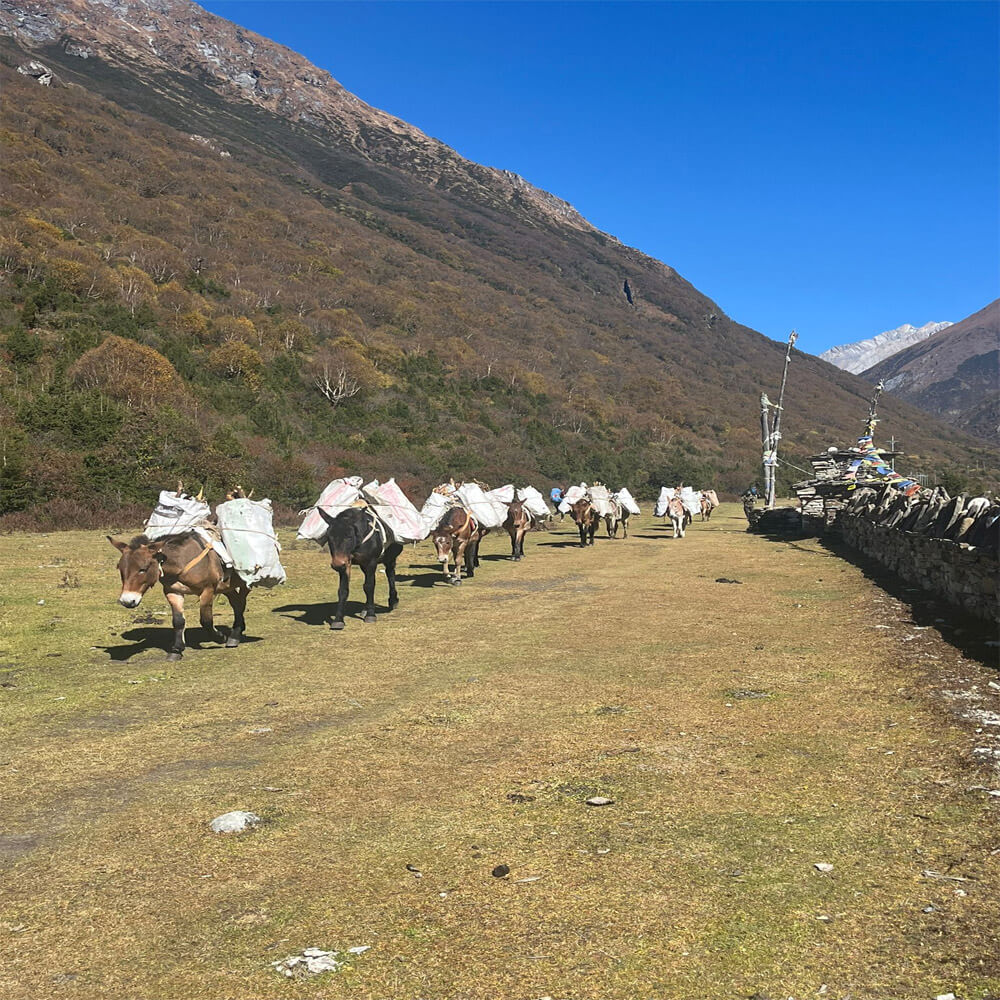
Since the Manaslu Circuit is a restricted region, trekking there requires many permissions. The Restricted Area Permit (RAP), which varies by season, is the primary expense which impact Manaslu Circuit Trek cost. It is somewhat less expensive per week during off-season months, although it is more expensive during peak season (September to November). The Manaslu Conservation Area Permit (MCAP) and the Annapurna Conservation Area Permit (ACAP) are also required for trekkers. These permits benefit local communities, preserve wildlife, and keep routes in good condition. You must also employ a qualified trekking service to handle all paperwork because trekking here requires a minimum of two trekkers and a registered guide. Permit and documentation fees typically range from $100 to $150 per person.
Accommodation, Food, Guide, and Transportation Costs
The majority of lodging options on the Manaslu Circuit are teahouses, which are basic lodges managed by local families. You will often pay between $5 and $10 per night. Noodles, soups, pancakes, potatoes, and Dal Bhat are among the meals that cost between $5 and $8 each dish. Because mules or porters are used to carry supplies, prices rise further up. While hiring a porter costs about USD 20–25 per day, hiring a licensed guide costs about USD 25–30 per day. The most common modes of transportation from Kathmandu to the starting point, Soti Khola or Machha Khola, are local buses and private jeeps; the cost varies from USD 20 to USD 200, depending on your preferences. A 14–18 day journey typically costs between USD 900 and USD 1,500, depending on spending patterns, party size, and comfort level.
Packing List and Trek Preparation
Essential Clothing and Gear
It is crucial to pack strategically because the weather on the Manaslu Circuit might change drastically. You should pack layers of clothes, such as trekking pants, a warm fleece or down jacket, an outer shell that is waterproof and windproof, and moisture-wicking base layers. High-altitude winds and frigid mornings require thermal socks, gloves, warm hats, and a neck gaiter or buff. Strong, well-worn trekking boots are essential for footwear, as are evening slippers or sandals. Additional essentials are a -10°C sleeping bag, trekking poles, a headlamp, sunglasses, sunscreen, a hydration bladder or refillable water bottles, water purification tablets, or a filter. Always keep a compact first aid kit in your bag that includes blister plasters, personal medications, pain killers, and medication for altitude sickness.
Fitness, Training, and Health Preparation
Given the length and intensity of the Manaslu Circuit Trek, your body must be ready. Building stamina requires regular aerobic activities such as stair climbing, cycling, jogging, or walking for at least four to six weeks before to the expedition. Strength training for the thighs, calves, and core muscles is especially beneficial for lengthy walks and steep climbs. Appropriate acclimatization is crucial since trekking at elevations higher than 4,000 meters can result in Acute Mountain Sickness (AMS). Your body can adjust if you walk slowly, drink lots of water, and abstain from alcohol and tobacco. Purchase travel insurance that includes coverage for emergency helicopter evacuation and high-altitude treks. It is a good idea to get medical advice and vaccines from a doctor before to the trek. Being mentally and physically prepared guarantees a more secure and pleasurable Manaslu experience.
Manaslu vs Other Treks
Comparing Manaslu with Everest Base Camp Trek
The famed Everest Base Camp (EBC) Trek draws thousands of trekkers each, but the Manaslu Circuit provides a very different experience. Teahouses, lodges, and congested trails abound in EBC, particularly during the busiest times of the year. Manaslu, on the other hand, is far less crowded and offers seclusion and a sense of genuine wilderness. In Manaslu, trekkers come across isolated settlements, unspoiled scenery, and traditional communities with Tibetan influences that seem archaic. Manaslu offers a similarly magnificent vista, including views of Mt. Manaslu, Ganesh Himal, and Himalchuli, without the crowds that Everest does. Everest gives the grandeur of towering peaks like Everest and Lhotse.
Comparing Manaslu with Annapurna Circuit Trek
Another classic, the Annapurna Circuit is renowned for its high passes and varied vistas. But with more teahouses, roads, and busier pathways, its popularity has grown. There are naturally fewer trekkers in Manaslu because it is a restricted area and requires a special permit and a qualified guide. Trekkers will be able to witness unspoiled woods, secret monasteries, and traditional communities free from commercial influences thanks to this restriction, which protects the wilderness of the area. The profundity of Tibetan Buddhist culture in Manaslu, particularly in areas like Sama Gaun and Nubri Valley, is unparalleled, while Annapurna also provides exposure to other cultures.
Unique Appeal of Manaslu
Immersion in a distant Himalayan setting is what Manaslu is all about, not simply the trek. It feels more like an adventure than a normal trek because of the remoteness, the unspoiled scenery, and the genuine encounters with local people. Not only is crossing the Larkya La Pass a tourist attraction, but it also becomes a personal achievement. You can sense the rhythm of mountain life, as opposed to more commercial routes, with yak caravans, prayer flags flying across valleys, and locals coexisting peacefully with the hostile landscape.
Responsible and Sustainable Trekking in Manaslu
Respect Local Culture
In the Manaslu region, trekking is about respecting local culture as much as it is about adventure. The villages are traditional and far away. One can show respect for local customs by dressing modestly, getting permission before taking pictures, and participating in festivals and rituals in a polite manner. Greeting villagers with simple gestures, such as using Gurung or Tibetan phrases, can greatly increase goodwill.
Environmental Awareness
Trekking responsibly is necessary because of the delicate ecosystem of the Manaslu region. Reusable bottle use, avoiding litter, and reducing plastic usage all contribute to maintaining its unspoiled beauty. Nowadays, a lot of teahouses promote eco-friendly activities, and trekkers should do the same to avoid leaving any evidence of their presence in high-altitude passes, river valleys, and forests.
Supporting Local Communities
By booking accommodations in homestays or teahouses owned by locals, you may be confident that your trekking money is going directly to the communities. In addition to improving your experience, hiring porters and guides from neighboring communities, buying handicrafts, and trying the local food supports traditional livelihoods.
Safety and Preparedness
Being prepared is another aspect of responsible trekking. Essentials include acclimatization, proper fitness, top-notch equipment, and travel insurance. Following your guide's instructions, keeping an eye on the weather, and adhering to altitude restrictions all help to assure safety while reducing the negative effects on the environment and culture.
FAQs
How long does the Manaslu Circuit Trek take?
The trek typically lasts 14–18 days, depending on the starting point, pace, and acclimatization days. Most itineraries include a gradual ascent to cross Larkya La Pass (5,160m) and return via the same route or an alternative exit.
What is the difficulty level of the trek?
The Manaslu Circuit is moderate to challenging, requiring good fitness and high-altitude experience. Steep trails, long trekking days, and cold weather at higher elevations add to the challenge.
Do I need special permits?
Yes. Trekkers must obtain a Restricted Area Permit (RAP), along with ACAP and MCAP permits. Traveling with a licensed guide is mandatory in restricted regions.
When is the best time to trek?
The ideal seasons are spring (March–May) and autumn (September–November). These months offer clear skies, moderate temperatures, and the best views of Mt. Manaslu and surrounding peaks.
What can I expect culturally and scenically?
Expect authentic Himalayan culture, including Gurung and Tibetan-influenced villages, monasteries, prayer flags, and mani walls. Panoramic mountain views, high passes, rivers, and suspension bridges provide an unforgettable natural experience.
Conclusion: Manaslu Circuit Trekking Adventure
The Manaslu Circuit Trek is a voyage into the heart of Nepal's untamed soul, not just a trekking excursion. It provides quiet, raw scenery, and genuine cultural interactions with Gurung, Tibetan, and Nubri populations, in contrast to congested pathways. Trekkers can enjoy stunning Himalayan views when they cross high passes like Larkya La, and the communities along the way provide hospitable people and centuries-old customs.
Although the journey is physically and mentally taxing, every step deepens one's connection to the natural world and the locals who live in these isolated valleys. While maintaining the unspoiled beauty of this area, traveling with a reputable company like Nepal Trekking Routes guarantees safety and direction. For anyone seeking adventure, cultural immersion, and untouched Himalayan wilderness, the Manaslu Circuit is an unforgettable journey that stays in the heart long after the trek ends.

